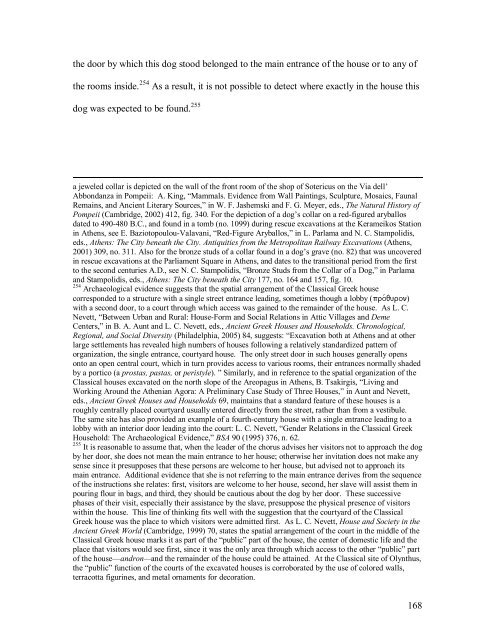The Judgment of Animals in Classical Greece: Animal Sculpture and ...
The Judgment of Animals in Classical Greece: Animal Sculpture and ...
The Judgment of Animals in Classical Greece: Animal Sculpture and ...
Create successful ePaper yourself
Turn your PDF publications into a flip-book with our unique Google optimized e-Paper software.
the door by which this dog stood belonged to the ma<strong>in</strong> entrance <strong>of</strong> the house or to any <strong>of</strong><br />
the rooms <strong>in</strong>side. 254 As a result, it is not possible to detect where exactly <strong>in</strong> the house this<br />
dog was expected to be found. 255<br />
a jeweled collar is depicted on the wall <strong>of</strong> the front room <strong>of</strong> the shop <strong>of</strong> Sotericus on the Via dell’<br />
Abbondanza <strong>in</strong> Pompeii: A. K<strong>in</strong>g, “Mammals. Evidence from Wall Pa<strong>in</strong>t<strong>in</strong>gs, <strong>Sculpture</strong>, Mosaics, Faunal<br />
Rema<strong>in</strong>s, <strong>and</strong> Ancient Literary Sources,” <strong>in</strong> W. F. Jashemski <strong>and</strong> F. G. Meyer, eds., <strong>The</strong> Natural History <strong>of</strong><br />
Pompeii (Cambridge, 2002) 412, fig. 340. For the depiction <strong>of</strong> a dog’s collar on a red-figured aryballos<br />
dated to 490-480 B.C., <strong>and</strong> found <strong>in</strong> a tomb (no. 1099) dur<strong>in</strong>g rescue excavations at the Kerameikos Station<br />
<strong>in</strong> Athens, see E. Baziotopoulou-Valavani, “Red-Figure Aryballos,” <strong>in</strong> L. Parlama <strong>and</strong> N. C. Stampolidis,<br />
eds., Athens: <strong>The</strong> City beneath the City. Antiquities from the Metropolitan Railway Excavations (Athens,<br />
2001) 309, no. 311. Also for the bronze studs <strong>of</strong> a collar found <strong>in</strong> a dog’s grave (no. 82) that was uncovered<br />
<strong>in</strong> rescue excavations at the Parliament Square <strong>in</strong> Athens, <strong>and</strong> dates to the transitional period from the first<br />
to the second centuries A.D., see N. C. Stampolidis, “Bronze Studs from the Collar <strong>of</strong> a Dog,” <strong>in</strong> Parlama<br />
<strong>and</strong> Stampolidis, eds., Athens: <strong>The</strong> City beneath the City 177, no. 164 <strong>and</strong> 157, fig. 10.<br />
254 Archaeological evidence suggests that the spatial arrangement <strong>of</strong> the <strong>Classical</strong> Greek house<br />
corresponded to a structure with a s<strong>in</strong>gle street entrance lead<strong>in</strong>g, sometimes though a lobby (pro&quron)<br />
with a second door, to a court through which access was ga<strong>in</strong>ed to the rema<strong>in</strong>der <strong>of</strong> the house. As L. C.<br />
Nevett, “Between Urban <strong>and</strong> Rural: House-Form <strong>and</strong> Social Relations <strong>in</strong> Attic Villages <strong>and</strong> Deme<br />
Centers,” <strong>in</strong> B. A. Aunt <strong>and</strong> L. C. Nevett, eds., Ancient Greek Houses <strong>and</strong> Households. Chronological,<br />
Regional, <strong>and</strong> Social Diversity (Philadelphia, 2005) 84, suggests: “Excavation both at Athens <strong>and</strong> at other<br />
large settlements has revealed high numbers <strong>of</strong> houses follow<strong>in</strong>g a relatively st<strong>and</strong>ardized pattern <strong>of</strong><br />
organization, the s<strong>in</strong>gle entrance, courtyard house. <strong>The</strong> only street door <strong>in</strong> such houses generally opens<br />
onto an open central court, which <strong>in</strong> turn provides access to various rooms, their entrances normally shaded<br />
by a portico (a prostas, pastas, or peristyle). ” Similarly, <strong>and</strong> <strong>in</strong> reference to the spatial organization <strong>of</strong> the<br />
<strong>Classical</strong> houses excavated on the north slope <strong>of</strong> the Areopagus <strong>in</strong> Athens, B. Tsakirgis, “Liv<strong>in</strong>g <strong>and</strong><br />
Work<strong>in</strong>g Around the Athenian Agora: A Prelim<strong>in</strong>ary Case Study <strong>of</strong> Three Houses,” <strong>in</strong> Aunt <strong>and</strong> Nevett,<br />
eds., Ancient Greek Houses <strong>and</strong> Households 69, ma<strong>in</strong>ta<strong>in</strong>s that a st<strong>and</strong>ard feature <strong>of</strong> these houses is a<br />
roughly centrally placed courtyard usually entered directly from the street, rather than from a vestibule.<br />
<strong>The</strong> same site has also provided an example <strong>of</strong> a fourth-century house with a s<strong>in</strong>gle entrance lead<strong>in</strong>g to a<br />
lobby with an <strong>in</strong>terior door lead<strong>in</strong>g <strong>in</strong>to the court: L. C. Nevett, “Gender Relations <strong>in</strong> the <strong>Classical</strong> Greek<br />
Household: <strong>The</strong> Archaeological Evidence,” BSA 90 (1995) 376, n. 62.<br />
255 It is reasonable to assume that, when the leader <strong>of</strong> the chorus advises her visitors not to approach the dog<br />
by her door, she does not mean the ma<strong>in</strong> entrance to her house; otherwise her <strong>in</strong>vitation does not make any<br />
sense s<strong>in</strong>ce it presupposes that these persons are welcome to her house, but advised not to approach its<br />
ma<strong>in</strong> entrance. Additional evidence that she is not referr<strong>in</strong>g to the ma<strong>in</strong> entrance derives from the sequence<br />
<strong>of</strong> the <strong>in</strong>structions she relates: first, visitors are welcome to her house, second, her slave will assist them <strong>in</strong><br />
pour<strong>in</strong>g flour <strong>in</strong> bags, <strong>and</strong> third, they should be cautious about the dog by her door. <strong>The</strong>se successive<br />
phases <strong>of</strong> their visit, especially their assistance by the slave, presuppose the physical presence <strong>of</strong> visitors<br />
with<strong>in</strong> the house. This l<strong>in</strong>e <strong>of</strong> th<strong>in</strong>k<strong>in</strong>g fits well with the suggestion that the courtyard <strong>of</strong> the <strong>Classical</strong><br />
Greek house was the place to which visitors were admitted first. As L. C. Nevett, House <strong>and</strong> Society <strong>in</strong> the<br />
Ancient Greek World (Cambridge, 1999) 70, states the spatial arrangement <strong>of</strong> the court <strong>in</strong> the middle <strong>of</strong> the<br />
<strong>Classical</strong> Greek house marks it as part <strong>of</strong> the “public” part <strong>of</strong> the house, the center <strong>of</strong> domestic life <strong>and</strong> the<br />
place that visitors would see first, s<strong>in</strong>ce it was the only area through which access to the other “public” part<br />
<strong>of</strong> the house—<strong>and</strong>ron—<strong>and</strong> the rema<strong>in</strong>der <strong>of</strong> the house could be atta<strong>in</strong>ed. At the <strong>Classical</strong> site <strong>of</strong> Olynthus,<br />
the “public” function <strong>of</strong> the courts <strong>of</strong> the excavated houses is corroborated by the use <strong>of</strong> colored walls,<br />
terracotta figur<strong>in</strong>es, <strong>and</strong> metal ornaments for decoration.<br />
168

















